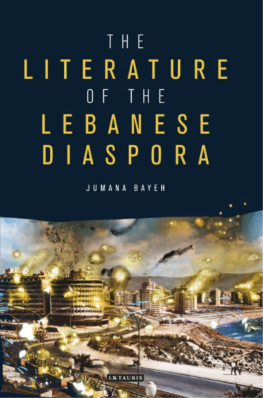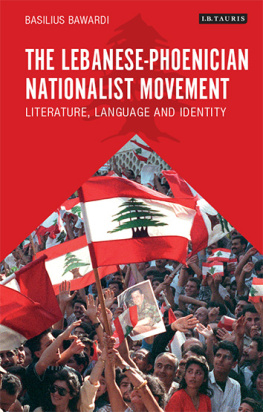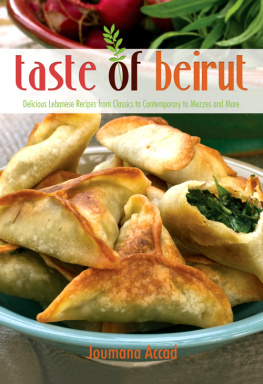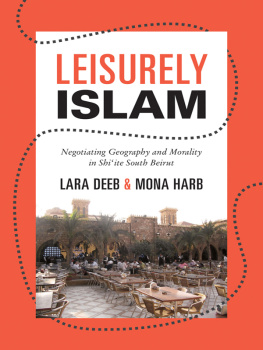Ghenwa Hayek is Assistant Professor of Arabic at Claremont McKenna College, California. She holds a PhD from Brown University in Comparative Literature.
BEIRUT,
IMAGINING
THE CITY
Space and Place in Lebanese Literature
G HENWA H AYEK
Published in 2015 by I.B.Tauris & Co Ltd
6 Salem Road, London W2 4BU
175 Fifth Avenue, New York NY 10010
www.ibtauris.com
Distributed in the United States and Canada
Exclusively by Palgrave Macmillan
175 Fifth Avenue, New York NY 10010
Copyright 2015 Ghenwa Hayek
The right of Ghenwa Hayek to be identified as the author of this work has been asserted by the author in accordance with the Copyright, Designs and Patents Act 1988.
All rights reserved. Except for brief quotations in a review, this book, or any part thereof, may not be reproduced, stored in or introduced into a retrieval system, or transmitted, in any form or by any means, electronic, mechanical, photocopying, recording or otherwise, without the prior written permission of the publisher.
Every attempt has been made to gain permission for the use of the images in this book. Any omissions will be rectified in future editions.
References to websites were correct at the time of writing.
Written Culture and Identity 2
ISBN: 978 1 78453 015 0
eISBN: 978 0 85773 670 3
A full CIP record for this book is available from the British Library
A full CIP record for this book is available from the Library of Congress
Library of Congress Catalog Card Number: available
Dedicated to my family, with love and gratitude
LIST OF ILLUSTRATIONS
Mazen Kerbaj, Its so Hard to Part from Beirut, Kerblog, p. 2
A panel from the autobiographical comic Mrabba w Laban (Jam and Yogurt) by Lena Merhej, p. 169
Mazen Kerbaj, One War Leads to Another (The Lebanese Wars Chronicles), 23 July 2006, p. 180
Exchanging stories about the Lebanese civil war, Ataqid by Lena Merhej, p. 188
Lena Merhej In the Sanayeh garden, I imagined the fountain erupting, as I had seen it at the Sukkars house/I solved the problem of the limited water supply at summer camp with my imagination as well/Since July 2006, I sometimes suddenly see the street transformed into the battlefield of a civil war: today, this ability to imagine makes me panic, p. 197
ACKNOWLEDGEMENTS
It is a mixed blessing to write acknowledgements: on the one hand, they highlight the fact that writing, no matter how solitary it may feel, is always a social endeavour; on the other, as with all projects that have unfolded over long stretches of time, they are a bittersweet reminder of the separations of time and distance from friends and family.
This project began as graduate work at Brown University, and owes a lot to the community of scholars there, and especially to Elliott Colla, Rda Bensmaa and Edward Ahearn, who first read it and saw its potential.
At MIT, I had the gentle encouragement of James Buzard, and a postdoctoral fellowship that enabled me to carve ample time out for writing and revising.
Since my arrival at Claremont McKenna College, I have found myself surrounded by a wonderful community. The Dean of Faculty, Nicholas Warner, provided much-appreciated support for this project. I am grateful to Marie-Denise Shelton and Bassam Frangieh for guiding me through the hurdles of my first year and early career in academia. I also owe a special thanks to my colleague Lee Skinner, who, in addition to welcoming us into her home and giving much-needed advice about navigating everyday life in southern California, patiently and enthusiastically read my work and helped me navigate the transition from dissertation to manuscript.
A big thank you to Azmina Siddique, Maria Marsh and Allison Walker at I.B.Tauris, who have been absolutely great every step of the way, and to Ian McDonald for his (literally!) much-needed copyediting skills. Jean-Pierre Watchi was generous enough to share his wonderful pictures of Beirut, and let us use one of them as the cover image un grand merci!
Parts of appear in a forthcoming publication on teaching Arabic literature. My thanks to Muhsin al-Musawi for his permission to reprint both pieces. A big thank you to Mazen Kerbaj and Lena Merhej for allowing me to use their beautiful images.
My life in Claremont would be a lot less productive without Friday work sessions with Pey-Yi Chu and Seo Young Park. It would also be a lot less fun without their companionship and support and, of course, dinner club.
I have a ton of gratitude and even more love for Nada Moumtaz, Hiba Bou Akar and Ellen Rentz, for reading parts of this book and helping me improve it with their carefully considered remarks and their honest critiques. Hooray for group video-critique sessions!
My decade of living in the United States has brought with it good and bad; I count my friendships with Teresa Villa-Ignacio, Kelley Krietz, Amy Vegari, Kathryn Chenoweth, Ariane Helou and Lara Deeb among the very, very good things that have happened along the way. Thank you all for the countless coffees, dinners and conversations.
I write about Beirut because it perplexes and troubles me, and, as this book shows, Im apparently not the only one. What is unequivocally great about Beirut are the people I love in it. There are too many to count, and all too many no longer live in Lebanon, but an especially big hug to Bana Bashour all of the Bashours, in fact Lina Mounzer, Sherine Shallah, George Nadda, Hatem Imam and Nisreen Salti.
I would not be where I am today without the love, support and encouragement of my family, immediate and extended. My mom and dad, Najia and Nicolas Hayek, supported my decision to leave Lebanon for graduate school, knowing that it would mean long chunks of absence. The magic of technology has allowed some of that absence to be bridged; in person or online, they are a daily source of love and support. My sister Munya was my first and probably harshest critic, and continues to push me to be better. The Hayeks and the Saouds both sides of my large, boisterous and deeply missed family in Lebanon gave me my first example of how personal stories fashion deep social bonds, and enable and enforce belonging, cohesion and connection. I miss them every day, and will be forever grateful for the stories; Im even more grateful, though, for their unconditional love.
Last, but not least, to Rami Jabakhanji, for an adventure-filled seven years that have brought us one war, several rounds of urban warfare, five moves across three states, countless road trips, one wedding and two PhDs: bhibbak, w barif laysh.
INTRODUCTION
FROM MOUNT LEBANON TO BEIRUT: THE SHIFTING LANDSCAPES OF LEBANESE FICTION
In Lebanese artist Mazen Kerbajs graphic weblog of the 2006 July war in Lebanon, black broad brushstrokes form the background and shape for an abstracted pieta. The connection between the artist and the city is emphasized and even day trips up to the mountains are represented as a challenge, the artist pining for the city down below. The citys image in Kerbajs representations keeps shifting, from the symbolic mother to a rudimentary sketch of a skyline, to an abstracted blackness outside Mazens window. Yet, in all its manifestations, Mazen is connected to it not merely by the fact of his physical presence or absence from it but because it is more than just an ordinary city: it is what gives him a sense of place.








